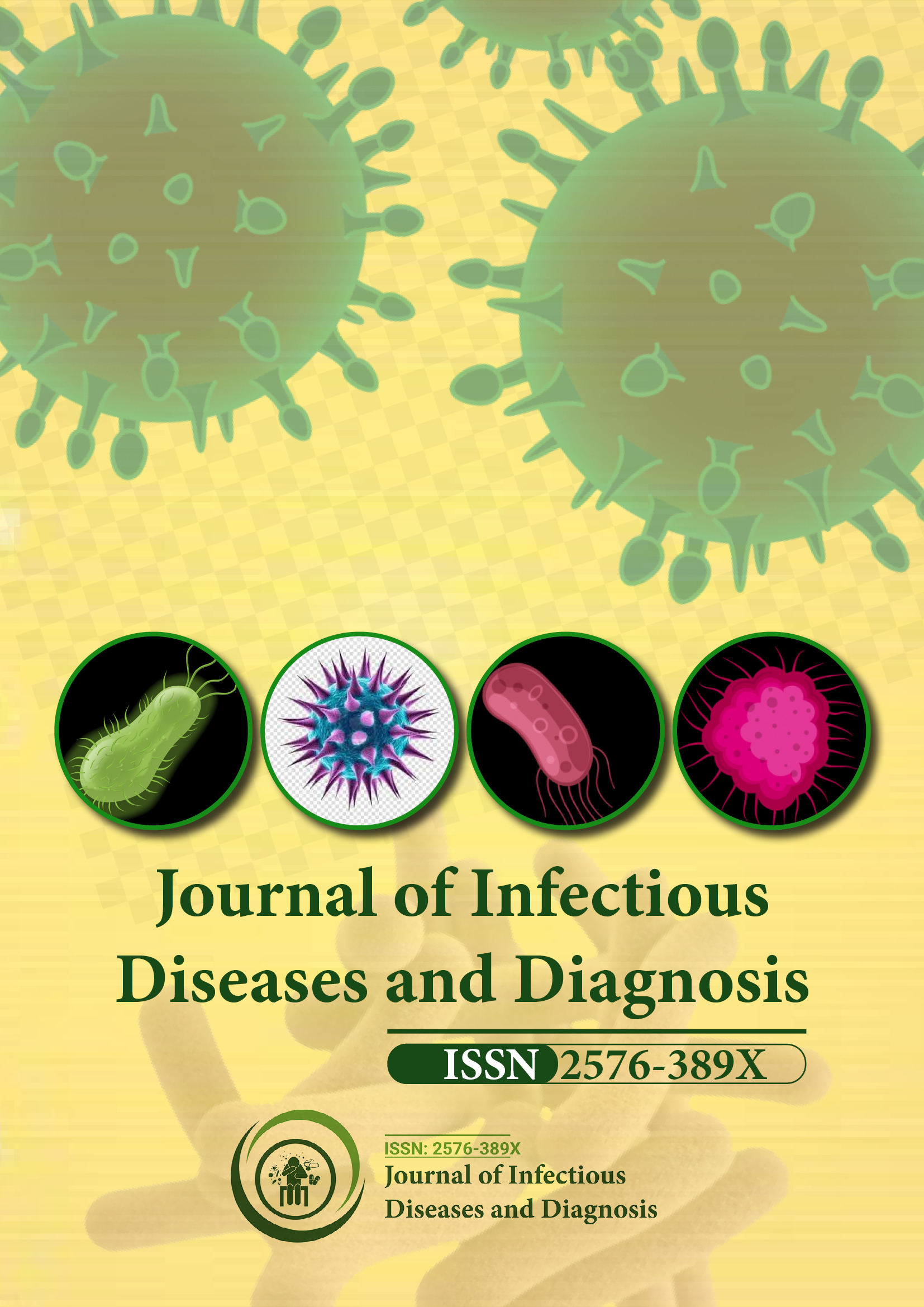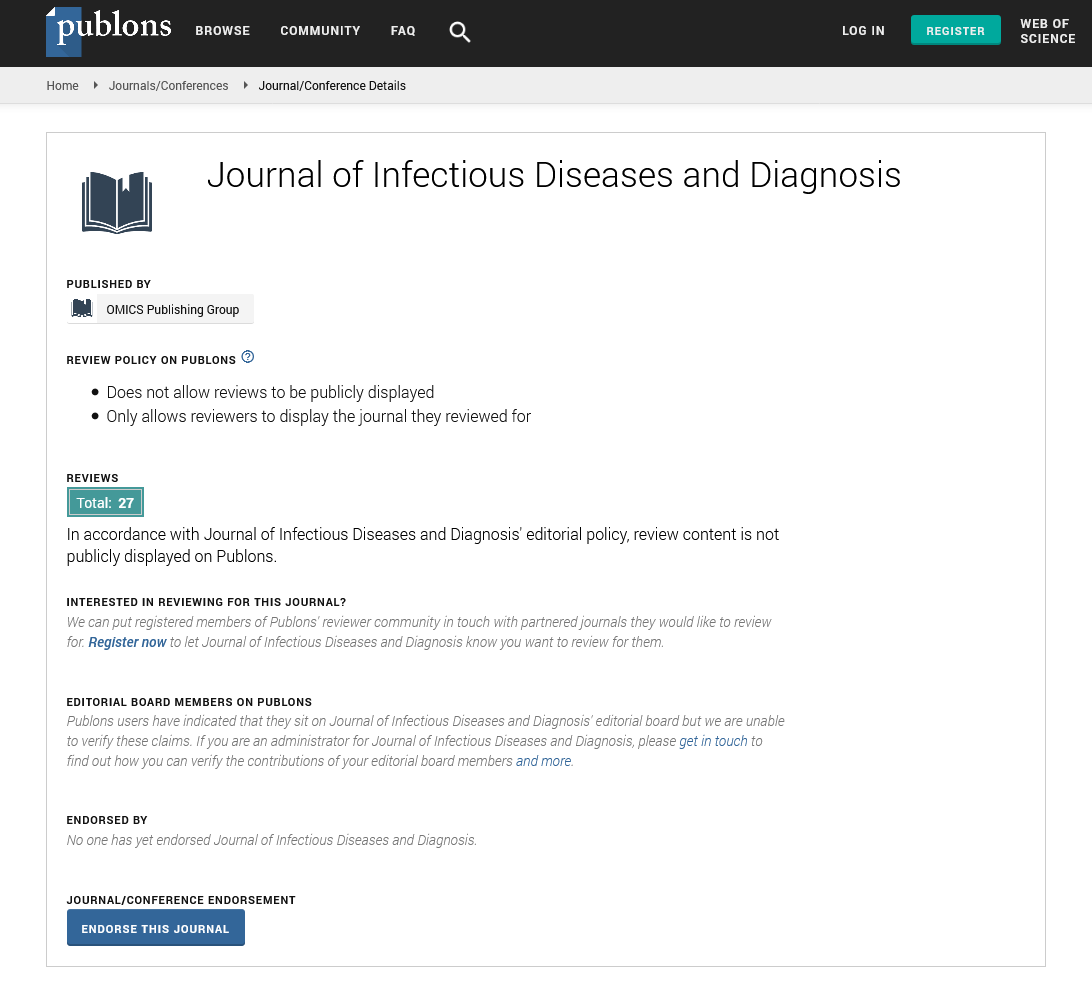Indexed In
- RefSeek
- Hamdard University
- EBSCO A-Z
- Publons
- Euro Pub
- Google Scholar
Useful Links
Share This Page
Journal Flyer

Open Access Journals
- Agri and Aquaculture
- Biochemistry
- Bioinformatics & Systems Biology
- Business & Management
- Chemistry
- Clinical Sciences
- Engineering
- Food & Nutrition
- General Science
- Genetics & Molecular Biology
- Immunology & Microbiology
- Medical Sciences
- Neuroscience & Psychology
- Nursing & Health Care
- Pharmaceutical Sciences
Opinion Article - (2025) Volume 10, Issue 4
Infection in Blood: Clinical Manifestations, Risk Factors and Management Approaches
Evangeline Watt*Received: 30-Jun-2025, Manuscript No. JIDD-25-29514; Editor assigned: 03-Jul-2025, Pre QC No. JIDD-25-29514 (PQ); Reviewed: 17-Jul-2025, QC No. JIDD-25-29514; Revised: 24-Jul-2025, Manuscript No. JIDD-25-29514 (R); Published: 31-Jul-2025, DOI: 10.35248/2576-389X.25.10.347
Description
Infections of the bloodstream, often referred to as septicemia or bacteremia, represent one of the most serious medical conditions due to their potential to affect multiple organ systems rapidly. Blood is normally a sterile environment and the presence of pathogens within it signifies a significant breach of host defenses. Once microorganisms gain access to the circulatory system, they can disseminate widely, releasing toxins and triggering severe immune responses. These infections are associated with high morbidity and mortality worldwide, making their early recognition and treatment a priority in healthcare.
Pathogenesis of blood infections
Bloodstream infections usually originate from a primary site of infection, such as the lungs, urinary tract, gastrointestinal tract, or skin. Pathogens may enter through breaches in mucosal barriers, surgical wounds, intravenous catheters, or indwelling medical devices. Once inside the bloodstream, bacteria, fungi, or viruses can multiply and release virulence factors that disrupt normal immune responses.
A major component of pathogenesis involves the host’s immune reaction. The immune system detects microbial components, such as lipopolysaccharides from Gram-negative bacteria or peptidoglycan from Gram-positive organisms and responds with a cascade of cytokines and inflammatory mediators. While this response aims to eliminate the pathogen, excessive activation can lead to widespread inflammation, capillary leakage, impaired tissue perfusion and eventually organ dysfunction.
Common causative agents
The spectrum of pathogens responsible for blood infections varies across populations and healthcare settings. Among bacteria, Escherichia coli, Klebsiella pneumoniae, Staphylococcus aureus, Streptococcus pneumoniae and Pseudomonas aeruginosa are frequent culprits. In hospital settings, multidrug-resistant organisms are increasingly implicated, complicating treatment. Fungal bloodstream infections, particularly those caused by Candida species, are common among immunocompromised patients, such as those undergoing chemotherapy, organ transplantation, or prolonged intensive care. Viral infections, such as those due to HIV or hepatitis viruses, can also lead to viremia, though their pathophysiology differs from bacterial or fungal septicemia.
Risk factors
Several conditions predispose individuals to bloodstream infections. These include:
- Compromised immune systems due to chronic illnesses, chemotherapy, or immunosuppressive therapy.
- Use of invasive devices such as catheters, prosthetic valves, or ventilators.
- Prolonged hospitalization, especially in intensive care units.
- Surgical procedures or trauma that disrupt physical barriers.
- Advanced age and underlying conditions like diabetes or renal failure.
Awareness of these risk factors is essential for prevention and early intervention.
Clinical manifestations
The presentation of blood infections can vary widely, from mild fever to life-threatening sepsis. Common symptoms include fever, chills, rapid heart rate, low blood pressure, confusion and difficulty breathing. In severe cases, septic shock may develop, characterized by persistent hypotension unresponsive to fluids and evidence of organ dysfunction such as renal impairment, coagulopathy, or altered mental status.
Because these infections can progress rapidly, timely recognition of signs is essential. Clinicians often rely on systemic inflammatory response criteria, organ function assessments and laboratory tests to guide diagnosis.
Diagnosis
The cornerstone of diagnosing bloodstream infections is the blood culture. This test isolates the causative organism, allowing for species identification and antimicrobial susceptibility testing. However, cultures may take several days to yield results and prior antibiotic therapy can reduce sensitivity.
Other diagnostic tools include polymerase chain reaction (PCR)-based assays, which detect microbial DNA directly from blood samples, providing faster results. Biomarkers such as procalcitonin and C-reactive protein are also employed to support the diagnosis, although they cannot replace pathogen-specific tests. Imaging studies may help identify primary sources of infection that have seeded the bloodstream, such as abscesses or pneumonia.
Treatment approaches
Management of bloodstream infections requires a combination of antimicrobial therapy, supportive care and control of the infection source. Empirical antibiotics are usually initiated immediately after cultures are obtained, with selection guided by likely pathogens and local resistance patterns. Once culture results are available, therapy is adjusted to target the specific organism.
For fungal infections, antifungal agents such as echinocandins or azoles are used. In cases of viral viremia, antiviral agents are considered, though treatment options are more limited. Alongside pharmacological therapy, removal of infected devices or drainage of abscesses may be necessary to eliminate the source.
Supportive measures include fluid resuscitation, oxygen therapy, vasopressors for hypotension and organ support in intensive care settings. Timely intervention significantly improves outcomes, as delays in appropriate therapy are associated with higher mortality.
Prevention Strategies
Prevention of bloodstream infections is a priority in both community and healthcare environments. Key measures include:
- Strict adherence to hand hygiene and aseptic techniques during medical procedures.
- Judicious use of invasive devices and timely removal when no longer needed.
- Antibiotic stewardship programs to limit the development of resistant organisms.
- Vaccination against pathogens such as Streptococcus pneumoniae and influenza, which can reduce secondary bloodstream infections.
In healthcare settings, protocols for catheter insertion, maintenance and monitoring have been shown to lower infection rates significantly.
Conclusion
Infections of the bloodstream remain a major challenge in medicine due to their rapid progression and high impact on patient outcomes. Advances in diagnostic technologies and antimicrobial therapies have improved detection and management, but prevention remains equally important. Ongoing efforts in surveillance, infection control and antibiotic stewardship are needed to limit the burden of bloodstream infections. As multidrug resistance continues to emerge, research into novel diagnostics and therapeutics will play an important role in addressing this global health concern.
Citation: Watt E (2025). Infection in Blood: Clinical Manifestations, Risk Factors and Management Approaches. J Infect Dis Diagn. 10:347.
Copyright: © 2025 Watt E. This is an open-access article distributed under the terms of the Creative Commons Attribution License, which permits unrestricted use, distribution and reproduction in any medium, provided the original author and source are credited.

